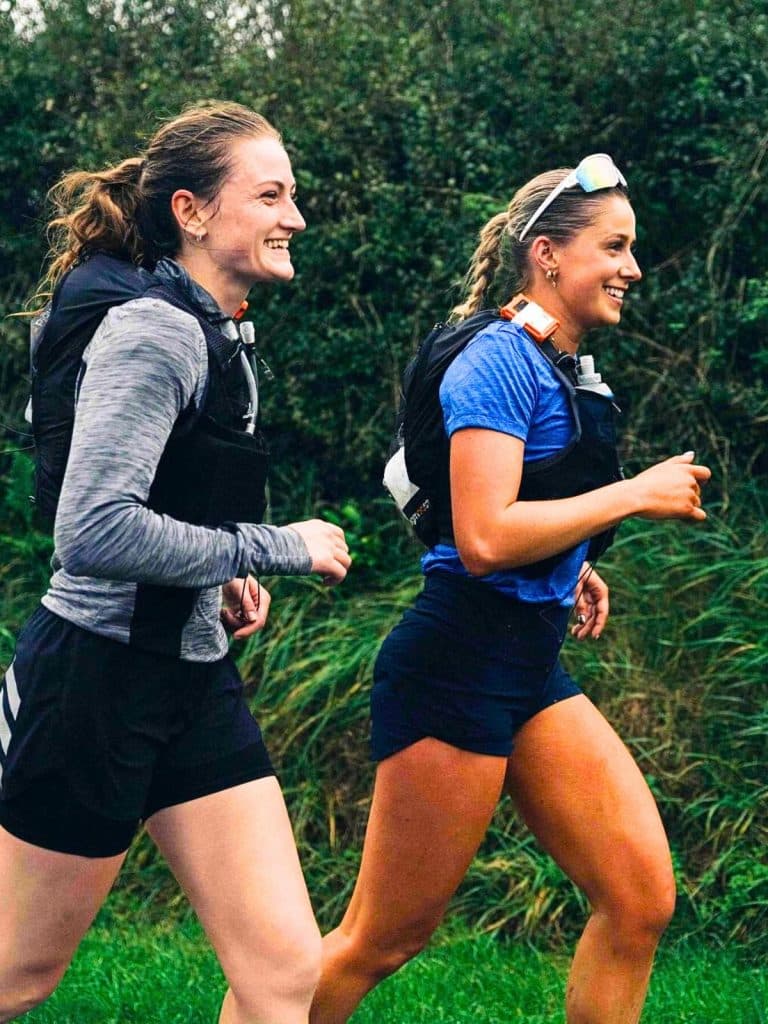Experienced runner, Louise Woffindin is on hand to help you make the move from 5km to 10km with her 5k-10k running plan.

Editorial Process: Our team of health and fitness professionals test each product in house. This review process is independent of the company and we always look to provide an unbiased assessment of the product in question – read our full editorial process here.
Fitness Brain is reader supported. Content may contain links and purchases made may earn us a commission. Find out more
Smashing a 5K race or graduating from a couch-to-5k program is a huge achievement. The 5K milestone is one that many new runners aspire to reach and it can take a while to build up to that non-stop 3.1 miles.
Once you’ve reached this goal it is common to think what next? Some people are happy to stick to 5K and enjoy trying to improve their time at their local parkrun. Others look for a new distance goal – the 10K.
Double The Distance
If you’ve only just achieved your first 5K, the thought of running it twice is pretty daunting. The good news, however, is that going from 5K to 10K is much easier than going from 0K to 5K!
You now know what running at length feels like; you’ve mastered regulating your breathing and pushing through barriers. Simply by following a few new training rules, you’ll be ready to take on your first 10K sooner than you think.
5K To 10K Training Rules
Before we introduce a basic training plan, it’s important to bear in mind some 10K training rules. Understanding how to build distance safely is vital for injury prevention. Here is some advice for all 5K to 10K runners.
#1 Build distance gradually
Yes, you’ve smashed your 5K and are feeling euphoric (and so you should be!), but don’t expect to be able to do 10K by next week. When building distance, it’s important to increase your mileage each week (with a little step back every few weeks too to recover). Going too far too soon will increase the likelihood of injury and it will probably shatter your confidence a little too.
#2 Rest days are important
Building up to a 10K distance is possible in three or four runs or training sessions per week. Any more than that and you risk injury. Ask any seasoned runner about injuries they’ve had and they’ll usually tell you it was down to overtraining. Rest days mean your muscles have time to recover and repair themselves.
#3 Cross-train
Cross-training simply means doing some exercise other than running. This helps give your running muscles time to recover while maintaining your fitness and strength. Lots of runners will tell you that the best cross-training is swimming. Swimming is a zero-impact activity that helps your muscles actively recover from running while maintaining your cardiovascular fitness too.
Other excellent examples of cross-training for runners is yoga or Pilates. These activities allow you to stretch your legs and improve your core strength, which is key to developing a good running posture. Cross-training can be done once or twice a week on non-running days while ensuring you have one complete rest day each week.
#4 Stretch after every run
If you’ve just completed a vigorous run, it can be so easy to flop onto your sofa or hop straight into the shower. However, ensuring you stretch all of your muscles is essential for injury prevention. You should stretch your calves, hamstrings, glutes, hip flexors and quads after each run. If you’re unsure how to perform these stretches, there are some great videos on YouTube you can follow. Once you know what you’re doing, make it a part of your post-run routine.
#5 Stick to one longer run per week
When you’re building up distance, you’ll be increasing your weekly mileage each week. This doesn’t mean that all 3 or 4 of your weekly runs are the same, longer distance. Your training plan should incorporate one longer weekly run that’s at a slower pace to build endurance. The other two runs would be shorter but faster and one is likely to be intervals.
#6 Incorporate one threshold session per week
Usually, your ‘threshold’ session will be done as interval training. This type of run is a great way to build endurance all while you prepare your body to run faster and longer. When you do your threshold run, you should feel discomfort but not exhaustion – and 80% effort as it were. At this intensity, you should struggle to talk but not be so tired that you can’t keep going for a little while.
This type of run is also fantastic for teaching yourself how to recover while you continue running. So, rather than doing 3 minutes at 80% effort then stopping to recover, doing 3 minutes at 80% effort then one minute at 60% effort will teach your body to keep going during effort recovery.
#7 Have a goal
Upping your distance is hard mentally as well as physically. Often, the hardest part of your run is getting out of your front door! Most runners find that setting themselves a goal keeps them motivated and committed to training.
Signing up for your first 10K race will really help to keep up the motivation and, because the 10K distance is so popular, you’ll find lots of great races to choose from too.
#8 Trust the plan (and the taper)
Whatever plan you use (and there are lots to choose from), you need to trust it. Many runners see how the mileage and long run distance decrease over the last few weeks and worry about not being ready. However, sticking to the taper is so important as it helps your body and muscles recover so you’re in peak condition come race day. Don’t be tempted to over train, it won’t make your race day any easier (and you’re more likely to sustain an injury).
Sample Training Plan – 5K to 10K
If you’re already comfortable running 5K, then an 8-week training plan is ideal. If you’ve done 5K once, you might want to spend a couple of weeks maintaining before starting to up your training to the 10K plan.
Here are some rough guides to what you should include in your 10K plan:
- 3 runs (non-consecutive days), one being a longer run and one being a hill session or interval session.
- One or two cross-training sessions (one swim, one yoga/Pilates is ideal)
- Rest days (one being after your long run day)
- Remember to stretch every day – even on rest days.
Here is a sample training plan for you to adapt:
| Week | Mon | Tues | Wed | Thurs | Fri | Sat | Sun | Total Miles |
| 1 | 30 min cross | 2.5 miles | 40 min cross | 2 miles | REST | 3 miles | REST | 7.5 |
| 2 | 30 min cross | 2.5 miles | 40 min cross | 2 miles | REST | 3.5 miles | REST | 8 |
| 3 | 35 min cross | 2.5 miles | 50 min cross | 2 miles | REST | 4 miles | REST | 8.5 |
| 4 | 35 min cross | 3 miles | 50 min cross | 2 miles | REST | 4 miles | REST | 9 |
| 5 | 35 min cross | 2 miles | 60 min cross | 3 miles | REST | 4.5 miles | REST | 9.5 |
| 6 | 40 min cross | 3 miles | 60 min cross | 2 miles | REST | 5 miles | REST | 10 |
| 7 | 40 min cross | 3 miles | 60 min cross | 2 miles | REST | 5.5 | REST | 10.5 |
| 8 | 30 min cross | 3 miles | 60 min cross | 2 miles | REST | RACE DAY | REST | 11 |
Final thoughts
There’s one final point to note when training for any race or distance: run your race and do not compare yourself to others.
The truth is, unless you are the fastest person in the world, there will always be someone faster than you. The most important part of going from 5K to 10K is getting in those 6.2 miles and not the speed that you do it in!
Good luck!
5-10K Training Plan Inspiration
Credits are from Instagram







